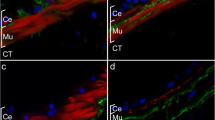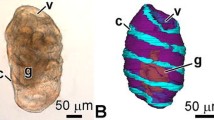Summary
The perivisceral coelom of the sea cucumber Parastichopus californicus is connected to the lumen of the hindgut by as many as 200 short transrectal ducts. Each duct is lined by a pseudostratified epithelium composed of: (i) monociliated, tonofilament-containing cells, (ii) myoepithelial cells, (iii) bundles of neurites, and (iv) granule-containing cells. In most places the lumen of each duct is lined by the monociliated, tonofilament-containing cells. The myoepithelial cells are predominantly basal in position and circular in orientation, but some border the lumen and parallel the long axis of the duct. The epithelium of a duct consists of the same types of cells as occur in the peritoneum covering the rectum and differs markedly from the nonciliated, cuticularized epithelium that lines the lumen of the rectum. Based on ultrastructural characteristics, the transrectal ducts represent evaginations of the peritoneum overlying the rectum and are thus “coelomoducts” sensu Goodrich. The possibility is discussed that perivisceral coelomoducts of holothuroids function in regulating coelomic volumes.
Similar content being viewed by others
Abbreviations
- AE :
-
adluminal epithelium
- AF :
-
anal fold
- ANC :
-
anal coelom
- AS :
-
anal sphincter muscle
- B :
-
bacterium
- BL :
-
basal lamina
- BW :
-
body wall
- CC :
-
coelomocyte
- CI :
-
cilium
- CO :
-
collagen fibers
- CT :
-
connective tissue
- CTE :
-
ciliated, tonofilament-containing epithelial cell
- D :
-
desmosome-like junction
- FB :
-
fibroblast
- GB :
-
Golgi bodies
- GC :
-
axon-like process of granule-containing cell
- HD :
-
hemidesmosome
- IJ :
-
intermediate junction
- INT :
-
intestine
- LM :
-
longitudinal muscles of body wall
- LRW :
-
luminal surface of rectal wall
- ME :
-
myoepithelial cell
- ML :
-
microlamellae
- MY :
-
myelin-like material
- NE :
-
neurite
- NV :
-
nerve
- NU :
-
nucleus
- OI :
-
opening of intestine into rectum
- PC :
-
perivisceral coelom
- PT :
-
peritoneum
- PTF :
-
papilliform tube feet
- RW :
-
rectal wall
- RL :
-
rectal lumen
- RS :
-
rectal suspensor
- RT :
-
respiratory trees
- SJ :
-
septate junction
- SO :
-
soma of adluminal epithelial cell
- SM :
-
subepidermal muscle
- TD :
-
transrectal duct
- TF :
-
tonofilaments
- WVC :
-
lateral water vascular canals
References
Anderson RS (1966) Anal pores in Leptosynapta clarki (Apoda). Can J Zool 44:1031–1035
Bachmann S, Goldschmid A (1978) Ultrastructural, fluorescence microscopic and microfluorimetric study of the innervation of the axial complex in the sea urchin Sphaerechinus granularis (Lam.). Cell Tissue Res 194:315–326
Becher S (1912) Beobachtungen an Labidoplox buski (M'Intosh). Z Wiss Zool 101:290–323
Bouland C, Massin C, Jangoux M (1982) The fine structure of the buccal tentacles of Holothuria forskali (Echinodermata: Holothuroidea). Zoomorphology 101:133–149
Byrne M (1984) Ultrastructural changes in the autotomy tissues of Eupentacta quinquesemita (Selenka) (Echinodermata: Holothuroidea) during evisceration. In: Keegan BF, O'Connor BD (eds) Proceedings of the Fifth International Echinoderm Conference. AA Balkema, Rotterdam, pp 413–420
Cameron JL, Fankboner PV (1984) Tentacle structure and feeding processes in life stages of the commercial sea cucumber Parastichopus californicus (Stimpson). J Exp Mar Biol Ecol 81:193–209
Cavey MJ, Cloney RA (1972) Fine structure and differentiation of ascidian muscle. I. Differentiated caudal musculature of Distaplia occidentalis tadpoles. J Morphol 138:349–372
Clark HL (1898) Synapta vivipara: a contribution to the morphology of echinoderms. Mem Boston Soc Nat Hist 5:53–88
Clark RB (1964) Dynamics of metazoan evolution. Oxford Univ Press, London, 313 pp
Clark RB (1979) Radiation of the Metazoa. In: House M (ed) The origin of the major invertebrate groups. Systematics Assoc Special Vol 12. Academic Press, London, pp 55–102
Cobb JLS, Raymond AM (1979) The basiepithelial nerve plexus of the viscera and coelom of eleutherozoan Echinodermata. Cell Tissue Res 202:155–163
Costello DP (1946) The swimming of Leptosynapta. Biol Bull 90:93–96
Doyle WL (1967) Vesiculated axons in the hemal vessel of a holothurian Cucumaria frondosa. Biol Bull 132:329–336
Dybas L, Fankboner P (1986) Holothurian survival strategies: mechanisms for the maintenance of a bacteriostatic environment in the coelomic cavity of the sea cucumber, Parastichopus californicus. Dev Comp Immunol 10:311–330
Estabrooks WA (1984) Structure of the ovotestis and release of gametes of a coelomic-brooding sea cucumber, Synaptula hydriformis (Lesueur, 1824) (Echinodermata: Holothuroidea). MS thesis, Florida Inst Tech, Melbourne, Florida, USA
Everingham J (1961) The intraovarian embryology of Leptosynapta clarki. MS thesis, Univ Washington, Seattle, Washington, USA
Feral JP, Massin C (1982) Digestive systems: Holothuroidea. In Jangoux M, Lawrence JM (eds) Echinoderm nutrition. AA Balkema, Rotterdam, pp 191–212
Gardiner SL, Rieger RM (1980) Rudimentary cilia in muscle cells of annelids and echinoderms. Cell Tissue Res 213:247–252
Glynn PW (1965) Active movements and other aspects of the biology of Astichopus and Leptosynapta (Holothuroidea). Biol Bull 119:80–86
Goodrich ES (1946) The study of nephridia and genital ducts since 1895. Q J Microsc Sci 86:113–392
Herreid CF, LaRussa VF, DeFesi CR (1976) Blood vascular system of the sea cucumber Stichopus moebii. J Morphol 150:423–452
Herreid CF, LaRussa VF, Defesi CR (1977) Vascular follicle system of the sea cucumber Stichopus californicus. J Morphol 154:19–30
Holland ND (1970) The fine structure of the axial organ of the feather star, Nemastar rubiginosa (Echinodermata: Crinoidea). Tissue Cell 2:265–636
Holland ND, Nealson KH (1978) The fine structure of the echinoderm cuticle and the subcuticular bacteria of echinoderms. Acta Zool (Stockholm) 59:169–185
Hyman LH (1955) The invertebrates: Echinodermata. McGraw-Hill Book Co, New York, 763 pp
Jangoux M (1982) Excretion. In: Jangoux M, Lawrence JM (eds) Echinoderm nutrition. AA Balkema, Rotterdam, pp 437–445
Jensen H (1975) Ultrastructure of the dorsal hemal vessel in the sea cucumber Parastichopus tremulus (Echinodermata: Holothuroidea). Cell Tissue Res 160:335–369
Kawaguti S (1964) Electron microscopy of the intestinal wall of the sea cucumber with special attention to its muscle and nerve plexus. Biol J Okayama Univ 10:39–50
Kawamoto N (1927) The anatomy of Caudina chilensis (J Muller) with especial reference to the perivisceral cavity, the blood and the water vascular systems in their relation to the blood circulation. Sci Rep Tohoku Imp Univ Ser 4 (Biol) 2:239–267
Kitao Y (1933) Notes on the anatomy of the young of Caudina chilensis (J Muller). Sci Rep Tohoku Imp Univ Ser 4 (Biol) 8:43–63
Kitao Y (1935) On the structure of anus of a holothurian, Caudina chilensis (J Muller). Sci Rep Tohoku Imp Univ Ser 4 (Biol) 9:447–453
Margolin A (1976) Swimming of the sea cucumber Parastichopus californicus (Stimpson) in response to sea stars. Ophelia 15:105–114
McLean N (1984) Ultrastructure of a coccidium (Apicomplexa: Sporozoa: Coccidia) in Priapulus caudatus (Priapulida). J Protozool 31:247–247
Menton DN, Eisen AZ (1970) The structure of the integument of the sea cucumber, Thyone briareus. J Morphol 131:17–36
Motokawa T (1982) Fine structure of the dermis of the body wall of the sea cucumber, Stichopus chloronotus, a connective tissue which changes its mechanical properties. Galaxea 1:55–64
Pantin C, Sawaya P (1953) Muscular action in Holothuria grisea. Bol Fac Cient Letr Univ Sao Paulo, Zoologia 18:51–59
Pentreath VW, Cobb JLS (1972) Neurobiology of Echinodermata. Biol Rev 47:363–392
Rieger RM (1986) Über den Ursprung der Bilateria: die Bedeutung der Ultrastrukturforschung für ein neues Verstehen der Metazoenevolution. Verh Dtsch Zool Ges 79:31–50
Rieger RM, Lombardi J (1987) Comparative ultrastructure of coelomic linings in echinoderm tube feet and the evolution of peritoneal linings in the Bilateria. Zoomorphology 107:191–208
Shinn GL (1985) Reproduction of Anoplodium hymanae, a turbellarian flatworm (Neorhabdocoela, Umagillidae) inhabiting the coelom of sea cucumbers; production of egg capsules, and escape of infective stages without evisceration of the host. Biol Bull 169:182–198
Smiley S, Cloney RA (1985) Ovulation and fine structure of the Stichopus californicus (Echinodermata: Holothuroidea) fecund ovarian tubules. Biol Bull 169:342–364
Smith DS, Wainwright SA, Baker J, Cavey ML (1981) Structural features associated with movement and “catch” of sea urchin spines. Tissue Cell 13:299–320
Smith T (1983) Tentacle ultrastructure and feeding behaviour of Neopentadactyla mixta (Holothuroidea: Dendrochirotida). J Mar Biol Assoc UK 63:301–311
Stricker S, Cloney R (1981) The stylet apparatus of the nemertean Paranemertes peregrina: its ultrastructure and role in prey capture. Zoomorphology 97:205–223
Turbeville JM, Ruppert EE (1985) Comparative ultrastructure and the evolution of nemertines. Am Zool 25:53–71
Vaney C (1925) L'incubation chez les Holothuries. Trav Sta Zool Wimereux 9:254–274
Welsch U, Storch V (1982) Fine structure of the coelomic epithelium of Sagitta elegans (Chaetognatha). Zoomorphology 100:217–222
Wilkie IC (1979) The juxtaligamental cells of Ophiocomina nigra (Abildgaard) (Echinodermata: Ophiuroidea) and their possible role in mechano-effector function of collagenous tissue. Cell Tissue Res 197:515–530
Wilkie IC (1984) Variable tensility in echinoderm collagenous tissues: a review. Mar Behav Physiol 11:1–34
Wood RL, Cavey MJ (1981) Ultrastructure of the coelomic lining in the podium of the starfish Stylasterias forreri. Cell Tissue Res 218:449–473
Author information
Authors and Affiliations
Rights and permissions
About this article
Cite this article
Shinn, G.L., Stricker, S.A. & Cavey, M.J. Ultrastructure of transrectal coelomoducts in the sea cucumber Parastichopus californicus (Echinodermata, Holothuroida). Zoomorphology 109, 189–199 (1990). https://doi.org/10.1007/BF00312470
Received:
Issue Date:
DOI: https://doi.org/10.1007/BF00312470




